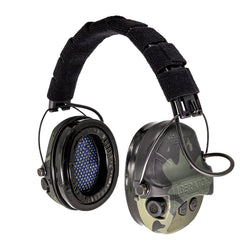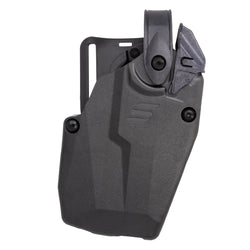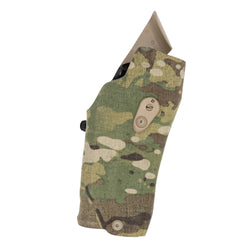“Bullpup” has to be one of the oddest terms ever applied to a type of firearm. The origin of the term is even somewhat lost to time. The closest anyone has ever been to figuring it out is British firearms expert Jonathan Ferguson.
His research indicates the term “bullpup” derived from bulldog puppies who were often seen as squat and ugly, but aggressive and powerful. That comparison was applied to rifles due to their short overall design. It’s not the first time the Brits used dog terms to describe guns, so it’s not a huge surprise.

The name fits since most bullpups certainly look odd, and being small is a major benefit of the concept. Although, to me, it’s more space age than ugly dog. These guns have a space blaster vibe that makes them recognizable.
What Is a Bullpup Firearm?
A bullpup is a type of firearm design where the action, breech, and magazine are located behind the trigger group, allowing for a shorter overall length while retaining the barrel length of a standard rifle. Most firearms place the breech ahead of the firing grip.
Bullpup firearms also often feature the magazine located behind the trigger, but this isn’t a defining feature. Magazine placement has varied depending on the bullpup platform. It’s easy to understand what a bullpup is, but what’s the point?
Benefits of the Bullpup Design
Bullpup firearms drastically reduce the overall size of a platform. For example, the Steyr AUG features a 20-inch barrel but is only 31.1 inches long overall. The M4 rifle features a 14.5-inch barrel but still measures 33 inches long overall.
Shorter guns are more maneuverable. Bullpup platforms are much easier to use when clearing rooms and fighting in close urban environments. Another overlooked advantage is operating them in and out of vehicles, where compactness is critical.

If you move into the world of submachine guns and personal defense weapons (PDWs), bullpups offer enhanced concealment. The United States Secret Service often uses the bullpup P90 PDW on protective details due to its ease of concealment.
A bullpup platform, specifically a rifle, pushes the weight to the rear of the gun, which positions it against the shoulder and is supported by the core. This makes it easier to hold in an aimed position for longer periods and makes the gun more intuitive to use with a single hand. The design pushes recoil more into the shoulder and reduces muzzle rise for increased control.
Downside to the Bullpup
The downside most users will immediately notice is reloads. Most bullpups put the magazine behind the firing hand, which makes it more difficult to reach and access. This makes reloads less intuitive and slower than most standard firearms.
Clearing malfunctions can also be more difficult since the action is behind the firing grip. It’s harder to see and access, and requires the shooter to break down their firing position. This creates slower malfunction clearance.

Most bullpups will also feature a spongy, somewhat heavy trigger. This is due to the linkage required to fire them. Some have improved bullpup triggers, but by and large, they are not match triggers.
Left-handed shooters face additional challenges. They often eject brass right into the shooter’s face when left-handed. Some have fixed this via bottom ejection, and others allow the user to swap ejection to the left side.

If we get into the weeds, we can point out a short sight radius, but in the modern era, we are all using optics anyway. Another downside is suppressor use, which can create gas blowback from the ejection port, right beside your face. Gas to the face is never comfortable.
A Short History Of Bullpup Rifles
Bullpup designs go way back! We are talking American Civil War and A1 sauce, old. The first recorded bullpup was a heavy bench-rest target rifle design in 1860 by Richard Potter of London. Another repeating design appeared in 1866, also in England.
This lends credibility to the naming convention being tied to “ugly, mean dogs.” Another English bullpup was the Thorneycroft carbine of 1901, a bolt-action .303 rifle. The first bullpup rifle used in combat was the Czech PzB M.SS.41 anti-tank rifle fielded during WWII.

After World War II, there was a lot of interest in the assault rifle concept, and some of that blended with the bullpup design. Unsurprisingly, the British pushed the idea with the EM-2. The Russians and Americans experimented with various bullpup designs in limited numbers.
In 1977, the Austrian Army adopted the Steyr AUG, which was a space-age bullpup featuring polymer construction, an integrated optic, and 5.56 NATO chambering. The AUG became one of the most popular bullpup rifles ever, adopted by over 20 countries around the Western world.

The French adopted the FAMAS in 1978, and the Brits adopted the L85 in 1985. Various other adoptions of bullpups have continued since then. The Israelis designed the TAVOR, the South African’s had the Vektor CR-21.
Everything has been bullpupped in one form or another — sniper rifles, shotguns, submachine guns, even pistols. These platforms have become popular with civilian shooters in numerous configurations.
Bullpups Today
Bullpups have seen some success, but the old joke goes: “Bullpups are the rifle of the future, and always will be.” If you dived deep into military forces that have adopted bullpups, you’ll often see that their special operations forces use standard configuration rifles.

You won’t see bullpups in the hands of champion shooters or most police forces. While they offer clear benefits, the downsides often outweigh them. The uncommon manual of arms and higher price remain barriers for many shooters.
Yet, bullpups continue to be produced, and they maintain a somewhat cult-like following. Development of the bullpup concept hasn’t stopped, and modern designs are getting better. Slowly, but the progress can’t be ignored.
It seems unlikely that bullpup rifles and other platforms will suddenly achieve success and replace the most common platforms. It seems unlikely that bullpup rifles and other platforms will suddenly replace traditional firearms. However, they’ve carved out a permanent niche in the firearms world and remain capable platforms for a variety of roles.
FAQ: Bullpup Firearms
Are bullpup rifles better than traditional rifles?
Bullpups are shorter and more maneuverable, but slower reloads and spongy triggers remain drawbacks.
Why do militaries use bullpup rifles?
They offer full-length barrels in compact packages, which is ideal for urban operations and vehicle use.
Are bullpups good for home defense?
They can be maneuverable in tight spaces, but their manual of arms may not be intuitive for all shooters.









